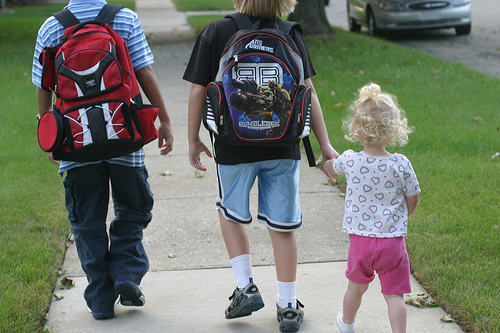This week, read about how being active helps your body deal with simple carbs, the importance of physical activity for academic achievement, soup’s on, and more.
Being Active Helps Your Body Deal with Simple Carbohydrates
 Gretchen Reynolds (New York Times) reported this week about a new study showing that walking 12,000 steps a day (about 6 miles/10 km) mitigated the negative impact of ingesting fructose.
Gretchen Reynolds (New York Times) reported this week about a new study showing that walking 12,000 steps a day (about 6 miles/10 km) mitigated the negative impact of ingesting fructose.
This may have to do with how the body uses carbohydrates. In exercising muscles, glycogen (stored carbohydrates) is an important source of fuel. Longer duration activity and more intense exercise depletes muscle glycogen: the body senses lower glycogen and prioritizes replenishing it. When active people eat carbohydrates, the carbohydrates are more likely to be converted to glycogen to fuel muscles (and if athletes neglect to eat enough carbohydrates, they won’t be at their prime for the next training session). In a sedentary person, carbohydrates aren’t needed as much to fuel muscles and are more likely to be stored as fat.
Exercise also improves insulin sensitivity and glucose tolerance: bodies that move are much better equipped to handle sugars. When diabetics exercise, they require less insulin to control their blood sugar. A study conducted last year showed that taking a short walk after meals can stabilize blood sugar and help prevent diabetes, suggesting that the timing of activity relative to eating might be important.
Elite endurance athletes rely on carbohydrates to fuel their performance, and manipulate the type and amount of carbohydrates they eat to match demands of training and racing. Sweet/simple carbohydrates are often the body’s preferred source of fuel during activity. For an extreme example, look at the sugars a world record marathoner would ingest during an event.
The impact of physical activity on carbohydrate needs is not new, but isn’t always considered in studies looking at the benefits of various types of diets. Last week a study showed weight loss and potential cardiovascular benefits to a lower carbohydrate diet, but this was conducted in a sedentary population.
I am not suggesting that we use exercise to compensate for overeating sugars and simple carbohydrates, but wondering if activity is an often-ignored but important variable to examine when looking at the influence of carbohydrates on health. Is the problem carbohydrates, or simply that people aren’t moving enough?
Physical Activity Improves Academic Achievement, Especially For Boys

Another study adds to the growing body of research that physical activity during school is important for academic achievement. This was one of the first studies to investigate different kinds of physical activity on cognitive skills. Finnish researchers found that in Grades 1-3, children who were more physically active during school recess were better readers than less active children. They also found that boys who walked or cycled to school were better readers than those who used non-active transport.
This study reinforces the accumulating evidence showing that what’s good for the body is good for the brain, and targeting the school environment to increase physical activity in youth should be a key strategy in health promotion. (Plos One, September 10, 2014).
Active transportation is an ideal opportunity for kids to get exercise on their way to and from school. Unfortunately the number of kids walking or cycling to school has decreased dramatically (in Canada 58% of parents report walking to school as kids, compared to only 28% of their children; in the US 48% of children walked or cycled to school in 1969 compared to only 13% children today). Recognizing the value of active transportation for health and academics, there are initiatives in place to increase active transport to school. For example Ottawa’s new Active Transportation Charter is piloting a Walking School Bus for kids to walk to school together with adult supervision. For more information, here’s an excellent summary on promoting active transportation in youth in Canada.
Cooler Weather Means Soup’s On!
 It’s no secret that I love Winter, and having Fall temperatures dramatically appear this week made me very happy. It also means that it’s finally time to start enjoying hot nutritious meals like soups and stews again. Here’s a simple Curried Butternut Squash Soup with Ginger soup that will make you as happy as I am that winter is coming.
It’s no secret that I love Winter, and having Fall temperatures dramatically appear this week made me very happy. It also means that it’s finally time to start enjoying hot nutritious meals like soups and stews again. Here’s a simple Curried Butternut Squash Soup with Ginger soup that will make you as happy as I am that winter is coming.
More links of interest this week:
- Small weight gains can raise blood pressure in healthy adults (a “feeding study” showed that gains as small as 5 lbs increase blood pressure. Those who gain weight in the stomach area (abdominal visceral fat) were more likely to see increases in blood pressure. (Presented at American Heart Association’s High Blood Pressure Research Scientific Sessions 2014.)
- Time is of the essence: How to best spend 30 minutes for your health. You guessed it – doing moderate to vigorous physical activity. (Obesity Panacea)
- Improving athletic track performance->research shows vertical visual cues affect performance in run-up events like long jump or high jump. (Queensland University of Technology)
- Music enhances performance & enjoyment of intense intervals. Blast your favourite tunes to go faster. (Medicine & Science in Sports & Exercise, September 8, 2014).
- Taking short walking breaks reverses negative effects of prolonged sitting. Sit a lot? Take breaks. (Medicine & Science in Sports & Exercise)
- Averting Diabetes Before It Takes Hold->excess weight & inactivity leading risk factors (Jane Brody, New York Times)
- Normal-Weight Counselors Feel More Successful Than Heavier Counselors at Helping Obese Patients Slim Down (Obesity, September 2014)
- Stop Googling your health questions. Excellent advice on finding evidence-based medicine. (Julia Beluz, Vox.com)
See More Issues of This Week in Food, Health, and Fitness
__________________
Walk to School Photo by Elizabeth/Table4Five 
Share This: